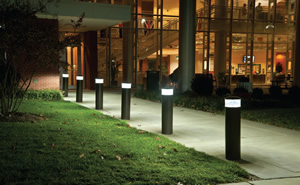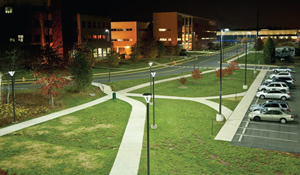Lighting the Way

PHOTOS COURTESY OF CREE, INC.
“A well-designed outdoor lighting system can offer environmental and financial benefits,” says John Casadonte, a product marketing manager at Cree, Inc. “Colleges and universities typically have large outdoor spaces or pathways that require significant lighting, and parking structures are often illuminated continuously, providing major opportunities for efficiency and lower costs.”
At the same time, the growing emphasis on campus security means that lighting must be more than just cost-effective, as desirable as that factor can be. For outdoor systems, dependable lighting must help create a safe environment for students, faculty, staff and visitors.
“With nighttime activities and students and staff moving about generally at all times, it is very important that lighting design provide adequate coverage and brightness levels in order to provide safety and security,” says Matthew Broyles of Firefly Lighting in Roswell, GA. In some ways this can be a matter of perception as much as reality, he adds. “Cohesion in the lighting pattern is important so that there are no dark zones which will make students or staff feel unsafe when on the campus after dark.”
Fortunately, recent advancements in technology, from more efficient lighting components to increasingly sophisticated controls, offer attractive opportunities for making the most of outdoor lighting systems.
Efficient and Attractive
On many campuses, planners have begun replacing lights with LED technology. Casadonte says that while current technology for outdoor light fixtures — such as halogen or HID (high intensity discharge) — offers the potential for high light output, they can be more costly than LED alternatives.
“With compact size, potential for great efficacy and lumen output, LED technology is practical from a performance and economic standpoint,” he says. He notes that some outdoor light fixtures deliver better light control and more uniform, white light than metal halide and may provide nearly maintenance-free lighting for up to 100,000 hours.
In addition, outdoor lighting in areas such as parking lots and structures, main pedestrian walkways, bike paths and campus building exteriors tend to be lit 24/7/365, Casadonte notes. With such high demand, the potential for savings can be substantial with the right technology.
“All types of older lighting systems can now be replaced by energy-saving LED technology,” says Steve Parrott, communication and marketing director for CAST Lighting. He reports that LEDs represent savings of between 60 and 90 percent, depending on the previous light source and fixture type. “Such system replacements will take some time, since the switchover may involve significant investment,” he says. “Of course, these investments will break even in a matter of months or years, so it makes financial sense to make the conversions.” Along with such practical considerations, the right lighting appeals from an aesthetic perspective, according to Parrott. “The key to creating a truly beautiful lighting scene is to engage the viewer with a visual experience that is both functional and magical,” he says. “Campus lighting should never be confined to merely ‘lighting’ the campus. It is, in fact, an opportunity to engage viewers in an aesthetic and uplifting experience.”
Smart Controls
Another area seeing recent progress is how lights are controlled. With some of the newer technologies, highly efficient “smart systems” include sensors that detect occupancy and ambient light, as well as controls using intelligent switching and dimming for individual fixtures and groups of fixtures.
These efficient lighting systems are adaptive, and bi-level controls, which switch lighting between a high and low level rather than on and off, are a smart choice for use in parking, area and roadway fixtures. The light fixtures can be outfitted with motion sensors, and when the area is unoccupied the lights remain be in a dim state with only a 35- to 50-percent light output. Once motion is detected, the fixtures will return to full brightness and will stay in this setting for five to 35 minutes based on pre-set choices. Other options are controlled by photocells or astronomical timeclocks, with no regard for actual traffic patterns or occupancy. While completely turning lights off is often unacceptable, switching between high and low light levels based on space occupancy maintains sufficient light for security and wayfinding, reduces light pollution and maximizes energy savings.
These systems can also offer the capability to generate usage reports, which facilities managers and engineers can use to make lit spaces even more efficient. In fact, the capability for adaptation to varying circumstances can be seen not just a nicety, but also an emerging necessity.

PHOTOS COURTESY OF CREE, INC.
COMING OUT OF THE DARK. In 2009, Virginia’s George Mason University evaluated potential facility improvements across its three campuses and decided that two campuses — Fairfax and Prince William — would retrofit high-pressure sodium exterior lighting with state-of-the-art luminaires in the roadway, walkway and parking lot. The solution provides the university with a highly efficient exterior lighting system that works toward its long-term sustainability goals.
Worthwhile Investment
When it comes to return on investment, campus lighting may rank among the most promising of areas. In considering available options, care should be taken to select products based on proven technologies.
It is imperative that campus administrators take the time to research the various lighting technologies available. The industry has witnessed instances where LED and LEP (light-emitting plasma) technologies were rushed to market based on efficiency claims and initial projections.
Once the tests on these technologies were completed, many of the initial claims had to be scaled down to accurately portray what the technologies were capable of. It is exceedingly important to investigate various lighting technologies. In the process, expert assistance may be needed.
“There is a learning curve with any new technology,” Parrott says. “Campus engineers and facility staff can’t expect to be fully up to speed with these evolving lighting options. For this reason, experts need to be consulted.” Parrott encourages college officials to attend lighting trade shows such as LightFair (www.lightfair.com), consult with local lighting agencies, and contact the Association of Outdoor Lighting Professionals (www.aolponline.org) for referrals to authoritative help.
This article originally appeared in the issue of .